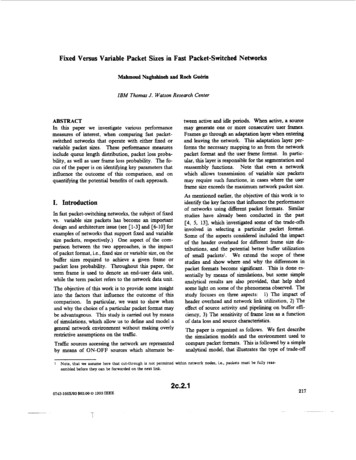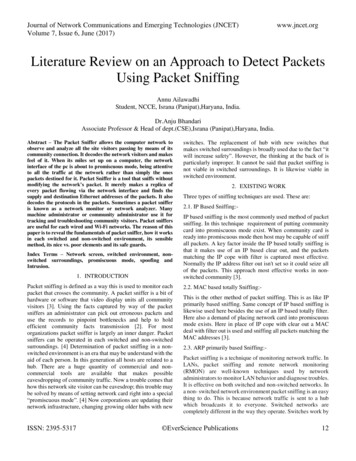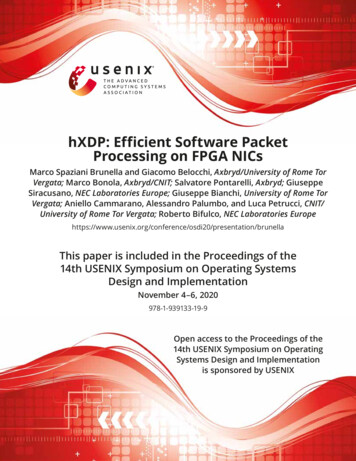
Transcription
hXDP: Efficient Software PacketProcessing on FPGA NICsMarco Spaziani Brunella and Giacomo Belocchi, Axbryd/University of Rome TorVergata; Marco Bonola, Axbryd/CNIT; Salvatore Pontarelli, Axbryd; GiuseppeSiracusano, NEC Laboratories Europe; Giuseppe Bianchi, University of Rome TorVergata; Aniello Cammarano, Alessandro Palumbo, and Luca Petrucci, CNIT/University of Rome Tor Vergata; Roberto Bifulco, NEC Laboratories sentation/brunellaThis paper is included in the Proceedings of the14th USENIX Symposium on Operating SystemsDesign and ImplementationNovember 4–6, 2020978-1-939133-19-9Open access to the Proceedings of the14th USENIX Symposium on OperatingSystems Design and Implementationis sponsored by USENIX
hXDP: Efficient Software Packet Processing on FPGA NICsMarco Spaziani Brunella1,3 , Giacomo Belocchi1,3 , Marco Bonola1,2 , Salvatore Pontarelli1 , GiuseppeSiracusano4 , Giuseppe Bianchi3 , Aniello Cammarano2,3 , Alessandro Palumbo2,3 , Luca Petrucci2,3 andRoberto Bifulco41 Axbryd, 2 CNIT, 3 Universityof Rome Tor Vergata, 4 NEC Laboratories EuropeAbstractFPGA accelerators on the NIC enable the offloading of expensive packet processing tasks from the CPU. However, FPGAshave limited resources that may need to be shared amongdiverse applications, and programming them is difficult.We present a solution to run Linux’s eXpress Data Pathprograms written in eBPF on FPGAs, using only a fractionof the available hardware resources while matching the performance of high-end CPUs. The iterative execution modelof eBPF is not a good fit for FPGA accelerators. Nonetheless, we show that many of the instructions of an eBPF program can be compressed, parallelized or completely removed,when targeting a purpose-built FPGA executor, thereby significantly improving performance. We leverage that to designhXDP, which includes (i) an optimizing-compiler that parallelizes and translates eBPF bytecode to an extended eBPFInstruction-set Architecture defined by us; a (ii) soft-CPU toexecute such instructions on FPGA; and (iii) an FPGA-basedinfrastructure to provide XDP’s maps and helper functions asdefined within the Linux kernel.We implement hXDP on an FPGA NIC and evaluate itrunning real-world unmodified eBPF programs. Our implementation is clocked at 156.25MHz, uses about 15% of theFPGA resources, and can run dynamically loaded programs.Despite these modest requirements, it achieves the packetprocessing throughput of a high-end CPU core and providesa 10x lower packet forwarding latency.1IntroductionFPGA-based NICs have recently emerged as a valid option tooffload CPUs from packet processing tasks, due to their goodperformance and re-programmability. Compared to other NICbased accelerators, such as network processing ASICs [8] ormany-core System-on-Chip SmartNICs [40], FPGA NICs provide the additional benefit of supporting diverse acceleratorsfor a wider set of applications [42], thanks to their embeddedhardware re-programmability. Notably, Microsoft has beenUSENIX Associationadvocating for the introduction of FPGA NICs, because oftheir ability to use the FPGAs also for tasks such as machinelearning [13, 14]. FPGA NICs play another important role in5G telecommunication networks, where they are used for theacceleration of radio access network functions [11, 28, 39, 58].In these deployments, the FPGAs could host multiple functions to provide higher levels of infrastructure consolidation,since physical space availability may be limited. For instance,this is the case in smart cities [55], 5G local deployments, e.g.,in factories [44,47], and for edge computing in general [6,30].Nonetheless, programming FPGAs is difficult, often requiringthe establishment of a dedicated team composed of hardwarespecialists [18], which interacts with software and operatingsystem developers to integrate the offloading solution with thesystem. Furthermore, previous work that simplifies networkfunctions programming on FPGAs assumes that a large shareof the FPGA is dedicated to packet processing [1, 45, 56], reducing the ability to share the FPGA with other accelerators.In this paper, our goal is to provide a more general and easyto-use solution to program packet processing on FPGA NICs,using little FPGA resources, while seamlessly integratingwith existing operating systems. We build towards this goal bypresenting hXDP, a set of technologies that enables the efficientexecution of the Linux’s eXpress Data Path (XDP) [27]on FPGA. XDP leverages the eBPF technology to providesecure programmable packet processing within the Linuxkernel, and it is widely used by the Linux’s community inproductive environments. hXDP provides full XDP support,allowing users to dynamically load and run their unmodifiedXDP programs on the FPGA.The eBPF technology is originally designed for sequentialexecution on a high-performance RISC-like register machine,which makes it challenging to run XDP programs effectivelyon FPGA. That is, eBPF is designed for server CPUs withhigh clock frequency and the ability to execute many of thesequential eBPF instructions per second. Instead, FPGAs favor a widely parallel execution model with clock frequenciesthat are 5-10x lower than those of high-end CPUs. As such,a straightforward implementation of the eBPF iterative exe-14th USENIX Symposium on Operating Systems Design and Implementation973
cution model on FPGA is likely to provide low packet forwarding performance. Furthermore, the hXDP design shouldimplement arbitrary XDP programs while using little hardware resources, in order to keep FPGA’s resources free forother accelerators.We address the challenge performing a detailed analysisof the eBPF Instruction Set Architecture (ISA) and of theexisting XDP programs, to reveal and take advantage of opportunities for optimization. First, we identify eBPF instructions that can be safely removed, when not running in theLinux kernel context. For instance, we remove data boundary checks and variable zero-ing instructions by providingtargeted hardware support. Second, we define extensions tothe eBPF ISA to introduce 3-operand instructions, new 6Bload/store instructions and a new parametrized program exitinstruction. Finally, we leverage eBPF instruction-level parallelism, performing a static analysis of the programs at compiletime, which allows us to execute several eBPF instructions inparallel. We design hXDP to implement these optimizations,and to take full advantage of the on-NIC execution environment, e.g., avoiding unnecessary PCIe transfers. Our designincludes: (i) a compiler to translate XDP programs’ bytecodeto the extended hXDP ISA; (ii) a self-contained FPGA IPCore module that implements the extended ISA alongsideseveral other low-level optimizations; (iii) and the toolchainrequired to dynamically load and interact with XDP programsrunning on the FPGA NIC.To evaluate hXDP we provide an open source implementation for the NetFPGA [60]. We test our implementationusing the XDP example programs provided by the Linuxsource code, and using two real-world applications: a simplestateful firewall; and Facebook’s Katran load balancer. hXDPcan match the packet forwarding throughput of a multi-GHzserver CPU core, while providing a much lower forwarding latency. This is achieved despite the low clock frequency of ourprototype (156MHz) and using less than 15% of the FPGAresources. In summary, we contribute: the design of hXDP including: the hardware design; thecompanion compiler; and the software toolchain; the implementation of a hXDP IP core for the NetFPGA a comprehensive evaluation of hXDP when running realworld use cases, comparing it with an x86 Linux server. a microbenchmark-based comparison of the hXDP implementation with a Netronome NFP4000 SmartNIC,which provides partial eBPF offloading support.2Concept and overviewIn this section we discuss hXDP goals, scope and requirements, we provide background information about XDP, andfinally we present an overview of the hXDP design.974Figure 1: The hXDP concept. hXDP provides an easy-to-usenetwork accelerator that shares the FPGA NIC resources withother application-specific accelerators.2.1Goals and RequirementsGoals Our main goal is to provide the ability to run XDPprograms efficiently on FPGA NICs, while using little FPGA’shardware resources (See Figure 1).A little use of the FPGA resources is especially important, since it enables extra consolidation by packing differentapplication-specific accelerators on the same FPGA.The choice of supporting XDP is instead motivated by atwofold benefit brought by the technology: it readily enablesNIC offloading for already deployed XDP programs; it provides an on-NIC programming model that is already familiarto a large community of Linux programmers. Enabling sucha wider access to the technology is important since many ofthe mentioned edge deployments are not necessarily handledby hyperscale companies. Thus, the companies developingand deploying applications may not have resources to investin highly specialized and diverse professional teams of developers, while still needing some level of customization toachieve challenging service quality and performance levels.In this sense, hXDP provides a familiar programming modelthat does not require developers to learn new programmingparadigms, such as those introduced by devices that supportP4 [7] or FlowBlaze [45].Non-Goals Unlike previous work targeting FPGA NICs [1,45, 56], hXDP does not assume the FPGA to be dedicated tonetwork processing tasks. Because of that, hXDP adopts aniterative processing model, which is in stark contrast with thepipelined processing model supported by previous work. Theiterative model requires a fixed amount of resources, no matterthe complexity of the program being implemented. Instead,in the pipeline model the resource requirement is dependenton the implemented program complexity, since programs areeffectively "unrolled" in the FPGA. In fact, hXDP providesdynamic runtime loading of XDP programs, whereas solutions like P4- NetFPGA [56] or FlowBlaze need to oftenload a new FPGA bitstream when changing application. Assuch, hXDP is not designed to be faster at processing packetsthan those designs. Instead, hXDP aims at freeing preciousCPU resources, which can then be dedicated to workloadsthat cannot run elsewhere, while providing similar or betterperformance than the CPU.Likewise, hXDP cannot be directly compared to SmartNICs dedicated to network processing. Such NICs’ resources14th USENIX Symposium on Operating Systems Design and ImplementationUSENIX Association
are largely, often exclusively, devoted to network packet processing. Instead, hXDP leverages only a fraction of an FPGAresources to add packet processing with good performance,alongside other application-specific accelerators, which sharethe same chip’s resources.Finally, hXDP is not providing a transparent offloadingsolution.1 While the programming model and the support forXDP are unchanged compared to the Linux implementation,programmers should be aware of which device runs their XDPprograms. This is akin to programming for NUMA systems,in which accessing given memory areas may incur additionaloverheads.Requirements Given the above discussion, we can derivethree high-level requirements for hXDP:1. it should execute unmodified compiled XDP programs,and support the XDP frameworks’ toolchain, e.g., dynamic program loading and userspace access to maps;2. it should provide packet processing performance at leastcomparable to that of a high-end CPU core;3. it should require a small amount of the FPGA’s hardwareresources.Before presenting a more detailed description of the hXDPconcept, we now give a brief background about XDP.2.2XDP PrimerXDP allows programmers to inject programs at the NIC driverlevel, so that such programs are executed before a networkpacket is passed to the Linux’s network stack. This providesan opportunity to perform custom packet processing at a veryearly stage of the packet handling, limiting overheads and thusproviding high-performance. At the same time, XDP allowsprogrammers to leverage the Linux’s kernel, e.g., selectinga subset of packets that should be processed by its networkstack, which helps with compatibility and ease of development. XDP is part of the Linux kernel since release 4.18, andit is widely used in production environments [4, 17, 54]. Inmost of these use cases, e.g., load balancing [17] and packetfiltering [4], a majority of the received network packets is processed entirely within XDP. The production deployments ofXDP have also pushed developers to optimize and minimizethe XDP overheads, which now appear to be mainly relatedto the Linux driver model, as thoroughly discussed in [27].XDP programs are based on the Linux’s eBPF technology.eBPF provides an in-kernel virtual machine for the sandboxedexecution of small programs within the kernel context. Anoverview of the eBPF architecture and workflow is providedin Figure 2. In its current version, the eBPF virtual machinehas 11 64b registers: r0 holds the return value from in-kernelfunctions and programs, r1 r5 are used to store argumentsthat are passed to in-kernel functions, r6 r9 are registers1 Here,previous complementary work may be applied to help the automatic offloading of network processing tasks [43].USENIX AssociationFigure 2: An overview of the XDP workflow and architecture,including the contribution of this paper.that are preserved during function calls and r10 stores theframe pointer to access the stack. The eBPF virtual machinehas a well-defined ISA composed of more than 100 fixedlength instructions (64b). The instructions give access to different functional units, such as ALU32, ALU64, branch andmemory. Programmers usually write an eBPF program usingthe C language with some restrictions, which simplify thestatic verification of the program. Examples of restrictionsinclude forbidden unbounded cycles, limited stack size, lackof dynamic memory allocation, etc.To overcome some of these limitations, eBPF programs canuse helper functions that implement some common operations, such as checksum computations, and provide accessto protected operations, e.g., reading certain kernel memoryareas. eBPF programs can also access kernel memory areascalled maps, i.e., kernel memory locations that essentially resemble tables. Maps are declared and configured at compiletime to implement different data structures, specifying thetype, size and an ID. For instance, eBPF programs can usemaps to implement arrays and hash tables. An eBPF programcan interact with map’s locations by means of pointer deference, for un-structured data access, or by invoking specifichelper functions for structured data access, e.g., a lookup on amap configured as a hash table. Maps are especially importantsince they are the only mean to keep state across program executions, and to share information with other eBPF programsand with programs running in user space. In fact, a map canbe accessed using its ID by any other running eBPF programand by the control application running in user space. Userspace programs can load eBPF programs and read/write mapseither using the libbf library or frontends such as the BCCtoolstack.XDP programs are compiled using LLVM or GCC, and thegenerated ELF object file is loaded trough the bpf syscall,specifying the XDP hook. Before the actual loading of a program, the kernel verifier checks if it is safe, then the programis attached to the hook, at the network driver level. Wheneverthe network driver receives a packet, it triggers the executionof the registered programs, which starts from a clean context.14th USENIX Symposium on Operating Systems Design and Implementation975
2.3ChallengesTo grasp an intuitive understanding of the design challengeinvolved in supporting XDP on FPGA, we now consider theexample of an XDP program that implements a simple stateful firewall for checking the establishment of bi-directionalTCP or UDP flows, and to drop flows initiated from an external location. We will use this function as a running examplethroughout the paper, since despite its simplicity, it is a realistic and widely deployed function.The simple firewall first performs a parsing of the Ethernet,IP and Transport protocol headers to extract the flow’s 5-tuple(IP addresses, port numbers, protocol). Then, depending onthe input port of the packet (i.e., external or internal) it eitherlooks up an entry in a hashmap, or creates it. The hashmapkey is created using an absolute ordering of the 5 tuple values,so that the two directions of the flow will map to the samehash. Finally, the function forwards the packet if the inputport is internal or if the hashmap lookup retrieved an entry,otherwise the packet is dropped. A C program describing thissimple firewall function is compiled to 71 eBPF instructions.We can build a rough idea of the potential best-case speedof this function running on an FPGA-based eBPF executor,assuming that each eBPF instruction requires 1 clock cycleto be executed, that clock cycles are not spent for any otheroperation, and that the FPGA has a 156MHz clock rate, whichis common in FPGA NICs [60]. In such a case, a naive FPGAimplementation that implements the sequential eBPF executorwould provide a maximum throughput of 2.8 Million packets per second (Mpps).2 Notice that this is a very optimisticupper-bound performance, which does not take into accountother, often unavoidable, potential sources of overhead, suchas memory access, queue management, etc. For comparison,when running on a single core of a high-end server CPUclocked at 3.7GHz, and including also operating system overhead and the PCIe transfer costs, the XDP simple firewallprogram achieves a throughput of 7.4 Million packets persecond (Mpps). 3 Since it is often undesired or not possible toincrease the FPGA clock rate, e.g., due to power constraints,in the lack of other solutions the FPGA-based executor wouldbe 2-3x slower than the CPU core.Furthermore, existing solutions to speed-up sequential codeexecution, e.g., superscalar architectures, are too expensivein terms of hardware resources to be adopted in this case. Infact, in a superscalar architecture the speed-up is achievedleveraging instruction-level parallelism at runtime. However,the complexity of the hardware required to do so grows exponentially with the number of instructions being checkedfor parallel execution. This rules out re-using general purpose2 I.e., the FPGA can run 156M instructions per second, which divided bythe 55 instructions of the program’s expected execution path gives a 2.8Mprogram executions per second. Here, notice that the execution path comprises less instructions that the overall program, since not all the program’sinstructions are executed at runtime due to if-statements.3 Intel Xeon E5-1630v3, Linux kernel v.5.6.4.976soft-core designs, such as those based on RISC-V [22, 25].2.4hXDP OverviewhXDP addresses the outlined challenge by taking a softwarehardware co-design approach. In particular, hXDP providesboth a compiler and the corresponding hardware module. Thecompiler takes advantage of eBPF ISA optimization opportunities, leveraging hXDP’s hardware module features that areintroduced to simplify the exploitation of such opportunities.Effectively, we design a new ISA that extends the eBPF ISA,specifically targeting the execution of XDP programs.The compiler optimizations perform transformations atthe eBPF instruction level: remove unnecessary instructions;replace instructions with newly defined more concise instructions; and parallelize instructions execution. All the optimizations are performed at compile-time, moving most of the complexity to the software compiler, thereby reducing the targethardware complexity. We describe the optimizations and thecompiler in Section 3. Accordingly, the hXDP hardware module implements an infrastructure to run up to 4 instructions inparallel, implementing a Very Long Instruction Word (VLIW)soft-processor. The VLIW soft-processor does not provideany runtime program optimization, e.g., branch prediction,instruction re-ordering, etc. We rely entirely on the compilerto optimize XDP programs for high-performance execution,thereby freeing the hardware module of complex mechanismsthat would use more hardware resources. We describe thehXDP hardware design in Section 4.Ultimately, the hXDP hardware component is deployed asa self-contained IP core module to the FPGA. The modulecan be interfaced with other processing modules if needed,or just placed as a bump-in-the-wire between the NIC’s portand its PCIe driver towards the host system. The hXDP software toolchain, which includes the compiler, provides all themachinery to use hXDP within a Linux operating system.From a programmer perspective, a compiled eBPF programcould be therefore interchangeably executed in-kernel or onthe FPGA, as shown in Figure 2.43hXDP CompilerIn this section we describe the hXDP instruction-level optimizations, and the compiler design to implement them.3.1Instructions reductionThe eBPF technology is designed to enable execution withinthe Linux kernel, for which it requires programs to includea number of extra instructions, which are then checked bythe kernel’s verifier. When targeting a dedicated eBPF executor implemented on FPGA, most such instructions could be4 Thechoice of where to run an XDP program should be explicitly takenby the user, or by an automated control and orchestration system, if available.14th USENIX Symposium on Operating Systems Design and ImplementationUSENIX Association
if (data sizeof(*eth)) data end)goto EOP;r4 r2r4 14if r4 r3 goto 60 LBB0 17 struct flow ctx table leafr4 0new flow {0};*(u32 *)(r10-4) r4struct flow ctx table key*(u64 *)(r10-16) r4flow key {0};*(u64 *)(r10-24) r4Figure 3: Examples of instructions removed by hXDPl4 data nh off;r4 r2r4 r2 42r4 42return XDP DROP;r0 1exit dropexitFigure 4: Examples of hXDP ISA extensionssafely removed, or they can be replaced by cheaper embeddedhardware checks. Two relevant examples are instructions formemory boundary checks and memory zero-ing.Boundary checks are required by the eBPF verifier to ensurethat programs only read valid memory locations, whenever apointer operation is involved. For instance, this is relevant foraccessing the socket buffer containing the packet data, duringparsing. Here, a required check is to verify that the packet islarge enough to host the expected packet header. As shown inFigure 3, a single check like this may cost 3 instructions, andit is likely that such checks are repeated multiple times. In thesimple firewall case, for instance, there are three such checksfor the Ethernet, IP and L4 headers. In hXDP we can safelyremove these instructions, implementing the check directly inhardware.Zero-ing is the process of setting a newly created variable tozero, and it is a common operation performed by programmers both for safety and for ensuring correct execution oftheir programs. A dedicated FPGA executor can provide hardguarantees that all relevant memory areas are zero-ed at program start, therefore making the explicit zero-ing of variablesduring initialization redundant. In the simple firewall functionzero-ing requires 4 instructions, as shown in Figure 3.3.2ISA extensionTo effectively reduce the number of instructions we define anISA that enables a more concise description of the program.Here, there are two factors at play to our advantage. First, wecan extend the ISA without accounting for constraints relatedto the need to support efficient Just-In-Time compilation. Second, our eBPF programs are part of XDP applications, and assuch we can expect packet processing as the main programtask. Leveraging these two facts we define a new ISA thatchanges in three main ways the original eBPF ISA.Operands number. The first significant change has to dealwith the inclusion of three-operand operations, in place ofeBPF’s two-operand ones. Here, we believe that the eBPF’sISA selection of two-operand operations was mainly dictatedUSENIX Associationby the assumption that an x86 ISA would be the final compilation target. Instead, using three-operand instructions allowsus to implement an operation that would normally need twoinstructions with just a single instruction, as shown in Figure 4.Load/store size. The eBPF ISA includes byte-aligned memory load/store operations, with sizes of 1B, 2B, 4B and 8B.While these instructions are effective for most cases, we noticed that during packet processing the use of 6B load/storecan reduce the number of instructions in common cases. Infact, 6B is the size of an Ethernet MAC address, which is acommonly accessed field both to check the packet destination or to set a new one. Extending the eBPF ISA with 6Bload/store instructions often halves the required instructions.Parametrized exit. The end of an eBPF program is markedby the exit instruction. In XDP, programs set the r0 to a valuecorresponding to the desired forwarding action (e.g., DROP,TX, etc), then, when a program exits the framework checksthe r0 register to finally perform the forwarding action (seelisting 4). While this extension of the ISA only saves one(runtime) instruction per program, as we will see in Section 4,it will also enable more significant hardware optimizations.3.3Instruction ParallelismFinally, we explore the opportunity to perform parallel processing of an eBPF program’s instructions. Here, it is important to notice that high-end superscalar CPUs are usuallycapable to execute multiple instructions in parallel, using anumber of complex mechanisms such as speculative executionor out-of-order execution. However, on FPGAs the introduction of such mechanisms could incur significant hardwareresources overheads. Therefore, we perform only a static analysis of the instruction-level parallelism of eBPF programs.To determine if two or more instructions can be parallelized,the three Bernstein conditions have to be checked [3]. Simplifying the discussion to the case of two instructions P1 , P2 :/ O1 I2 0;/ O2 O1 0;/I1 O2 0;(1)Where I1 , I2 are the instructions’ input sets (e.g. sourceoperands and memory locations) and O1 , O2 are their output sets. The first two conditions imply that if any of the twoinstructions depends on the results of the computation of theother, those two instructions cannot be executed in parallel.The last condition implies that if both instructions are storingthe results on the same location, again they cannot be parallelized. Verifying the Bernstein conditions and parallelizinginstructions requires the design of a suitable compiler, whichwe describe next.3.4Compiler designWe design a custom compiler to implement the optimizationsoutlined in this section and to transform XDP programs into14th USENIX Symposium on Operating Systems Design and Implementation977
a schedule of parallel instructions that can run with hXDP.The schedule can be visualized as a virtually infinite set ofrows, each with multiple available spots, which need to befilled with instructions. The number of spots corresponds tothe number of execution lanes of the target executor. The finalobjective of the compiler is to fit the given XDP program’sinstructions in the smallest number of rows. To do so, thecompiler performs five steps.Control Flow Graph construction First, the compiler performs a forward scan of the eBPF bytecode to identify theprogram’s basic blocks, i.e., sequences of instructions thatare always executed together. The compiler identifies the firstand last instructions of a block, and the control flow betweenblocks, by looking at branching instructions and jump destinations. With this information it can finally build the ControlFlow Graph (CFG), which represents the basic blocks asnodes and the control flow as directed edges connecting them.Peephole optimizations Second, for each basic block thecompiler performs the removal of unnecessary instructions(cf. Section 3.1), and the substitution of groups of eBPF instructions with an equivalent instruction of our extended ISA(cf. Section 3.2).Data Flow dependencies Third, the compiler discovers DataFlow dependencies. This is done by implementing an iterativealgorithm to analyze the CFG. The algorithm analyzes eachblock, building a data structure containing the block’s input,output, defined, and used symbols. Here, a symbol is anydistinct data value defined (and used) by the program. Onceeach block has its associated set of symbols, the compilercan use the CFG to compute data flow dependencies betweeninstructions. This information is captured in per-instructiondata dependency graphs (DDG).Instruction scheduling Fourth, the compiler uses the CFGand the learned DDGs to define an instruction schedule thatmeets the first two Bernstein conditions. Here, the compilertakes as input the maximum number of parallel instructionsthe target hardware can execute, and potential hardware constraints it needs to account for. For example, as we will see inSection 4, the hXDP executor has 4 parallel execution lanes,but helper function calls cannot be parallelized.To build the instructions schedule, the compiler considersone basic block at a time, in their original order in the CFG.For each block, the compiler assigns the instructions to thecurrent schedule’s row, starting from the first instruction inthe block and then searching for any other enabled instruction.An instruction is enabled for a given row when its data dependencies are met, and when the potential hardware constraintsare respected. E.g., an instruction that calls a helper functionis not enabled for a row that contains another such instruction.If the compiler cannot find any enabled instruction for thecurrent row, it creates a new row. The algorithm continuesuntil all the block’s instructions are assigned to a row.At this point, the c
2.2 XDP Primer XDP allows programmers to inject programs at the NIC driver level, so that such programs are executed before a network packet is passed to the Linux's network stack. This provides an opportunity to perform custom packet processing at a very early stage of the packet handling,limiting overheads and thus providing high-performance.
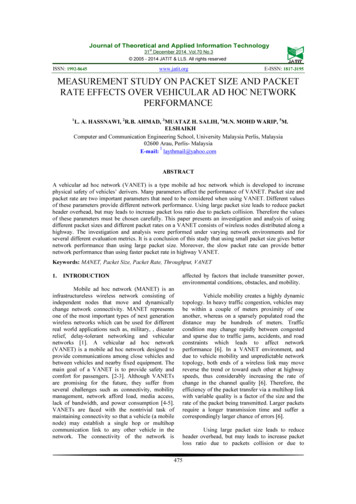

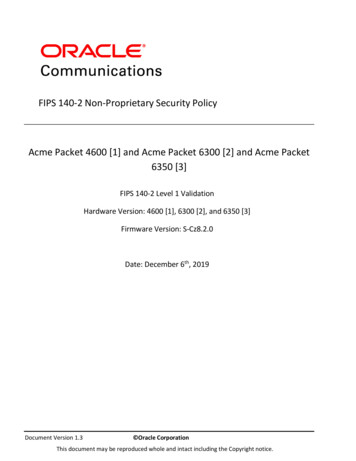
![FIPS 140-2 Non-Proprietary Security Policy Acme Packet 1100 [1] and .](/img/49/140sp3490-5601486.jpg)
